DEVELOP A MAINTENANCE MANUAL
Asset Management & Your Maintenance Manual
Asset management refers to the systems and compliance measures that contribute to the overall effectiveness of a business. Engineering, maintenance, supply, and logistics are the most common process drivers.
By meeting your company’s asset management objectives, you will ensure that your products and/or services are delivered on time, in entirety and to a pre-defined specification. Furthermore, probably the most significant deliverable of asset management is the capacity to ensure the long-term viability of your company’s assets, profits, and people.
Asset Management processes and activities save money, time, and effort by allowing your production department to satisfy short and long-term demands, give accurate forecasts, and ensure all essential resources are used efficiently.
Employees can explore notions of succession planning and, on a more personal level, can allow their families to be calm about their future, become established in their communities and have a welcome sense of fulfilment.
There is a lot to be gained by creating a steady, profitable, and well-balanced business.
Unfortunately, asset management is one of those aspects of running a business that is generally not thoroughly explored or fully comprehended at first, but develops rapidly over the test of time as external situations seek to affect your company’s success.

Establish Maintenance Effectiveness Metrics
Maintenance management metrics are important for analysing our current maintenance tactics and allow us to see how close to being successful we are. Measuring or quantifying the outcomes our maintenance performance in a number of key areas allows us to determine how much development or improvement will be required in the future.
It’s only through measurement and evaluation of our maintenance management metrics that we’re able to make decisions about which parts of our performance are or are not meeting the business needs, anything else is just someone’s gut feel.
The consistent application of an approved set of metrics improves our capacity to collaborate across the business, share leading practices, offer a framework for inner and external benchmarking & enhance the functionality of our people and processes. Understanding how our enterprise system & people performance goals intertwine over a measured period will reveal and force improvement.
Metrics selection for any process
should be based on an agreed upon understanding of the desired future state for
the company.
The metrics chosen for performance
monitoring should be able to spot significant or meaningful changes, by that I
mean changes that would require specified remedial actions. Frequently, fewer
well-accepted and well-understood measurements can promote improvement just as
effectively as more exact ones. The goal is to establish a number of indicators
for asset management procedures and work streams that can be systematically
measured and tracked across the entire company.
Setting up your maintenance metrics is
a step in the maintenance management process, and once you’ve selected each
metric, you’ll need to decide how to gather data and calculate it. There isn’t
really a single aspect of maintenance department that wouldn’t gain from a
quick review that could reveal unexpected issues with data or process integrity,
so wide participation in metric creation brainstorming sessions is encouraged.
Due to the fact that maintenance management systems rely on human data entry
from a highly diverse group of users, leaders must devote time and resources up
front to user training and alignment.
Other systems depend on high
reliability across multiple monitoring points such as process monitoring and
control systems like Citec and DCS, which may require the commitment up front
of fewer but more technically specialised resources. In both cases, auditing
should be carried out to understand and improve the overall integrity of the
metrics.

Set Maintenance Performance Baselines
You will need to establish baselines to
monitor performance improvement as part of the validation process. In some
circumstances, the baseline may need to be developed over the course of several
weeks or months after the measuring process are put into place.
It’s not just about new equipment; it
includes circumstances where there has been a significant change in the
measurement process, including how you use it or the relating business process
or if the process has not yet attained an acceptable level of stability.
Targets should ideally be attainable
within the anticipated timeframe and naturally, they need to be realistic.
Maintenance management processes can
use common analysis tools to enhance understanding and insights into
improvement opportunities with increased standardisation of systems and
processes throughout your firm. Obtaining this leverage through collaboration
is a responsibility shared by each department’s communities and networks.
Effective analysis with the participation of the individuals involved in the
process opens up major, but often overlooked, sources of value, such as
strengthening the process understanding of all persons involved.
This can frequently result in an effect
in which many small changes in behaviour and process use can lead to large
changes in overall performance, and the identification of improvement
opportunities should never be regarded as the sole domain of leaders; some of
the most significant improvement opportunities will undoubtedly be identified
by the operators, maintainers, and technicians doing the majority of the work.
When looking for examples of Maintenance
Metrics, you could start with just some simple ideas like the number of Breakdown
events for the period and you might like to work in a bit of FMECA, MTBF, MTTR
stuff in that data too?. Then move on
to the number of work order tasks scheduled versus the number of work order tasks
completed, the gross Labour Hrs for the period versus the estimated Labour Hrs
for period as well as the labour Hrs recorded on all work order tasks versus
the labour Hrs recorded on Scheduled work order tasks.
Creating Your Maintenance Manual is a process

The measurable benefits of an effective maintenance and engineering team can be a combination of improved return on capital expenditure, increased production output, being able to achieve production capacity, maximised equipment operating life, reduced inventory overheads & reduced operating costs per unit of production.
However, any possible benefits via maintenance and engineering activities will be meaningless unless policies, procedures & compliance activities are in place to ensure that all work is done without compromising the health and safety of personnel, the environment or relations with the community in which you operate. Causing harm to people, the environment or community relations can potentially threaten your licence to operate.
Basic Maintenance Workflows
A well planned and managed maintenance schedule (routine or outage) brings value to the bottom line while reducing safety concerns.
To do this, the Maintenance & Safety Processes must be very strong, adhered to and require the complete commitment of all Managers, Supervisors & Task Based Workers.
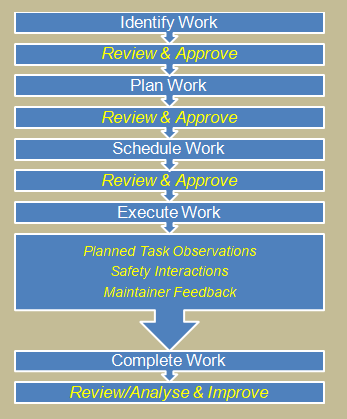
The urgency of the work to be executed is defined by the Work Order priority. A designation of ‘Priority 1’ is typically reserved for the most urgent tasks and usually has a specific ‘rapid response process’ to ensure prompt action. Because this does not go through the typical procedures for selecting, planning, and scheduling work, additional focus on safety is paramount, just because it’s urgent, doesn’t mean you put people in harms way and doesn’t mean it’s ok to damage the environment in the process. Urgent work can occasionally have a negative impact on the maintenance departments overall efficiency, sometimes there’s no option but to cannibalise parts from reserved planned job parts, urgent air and road freight costs, unusual work hours/shifts will necessitate the cancelling upcoming planned work.
The Management of Shutdowns, Turnarounds or Outage Events
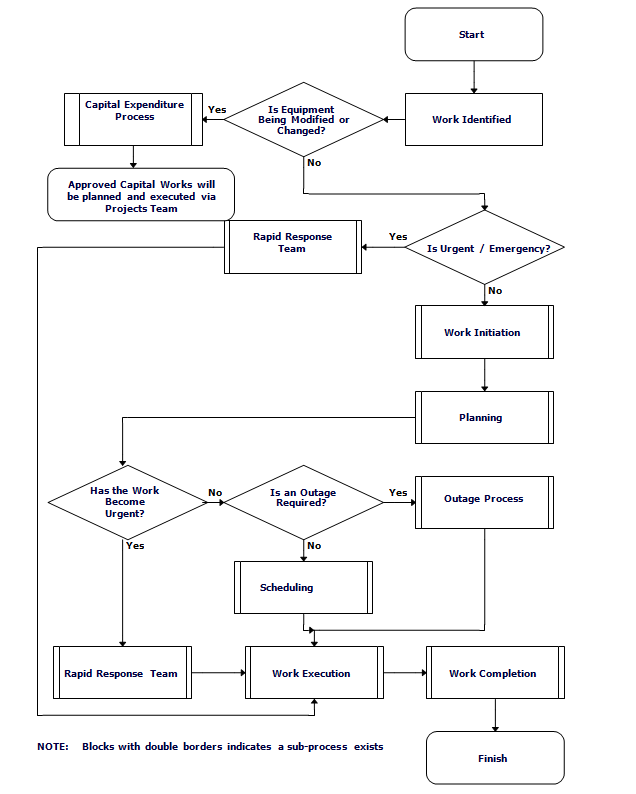
Although often very well planned, process facility shutdowns/outages are one of the riskier situations faced by Maintenance Departments in the heavy industrial industries. Typically, the two main areas requiring risk mitigation relate to production and safety issues. When planning and scheduling maintenance shutdowns, all perceived & recognised threats and hazards must be considered.
The majority of operations will have very solid safety procedures in place and take compliance with isolations and “permit to work” procedures very seriously, significantly lowering the risks. Unfortunately, there will be Production departments that solely control the frequency and length of maintenance shutdowns, resulting in less outage downtime, less frequently. The risk to plant and equipment performance in these scenarios is that proper maintenance may not be prioritised.
Process & Instrumentation Diagrams

Process and Instrumentation Diagrams (P&IDs), also known as piping & instrumentation diagrams are schematic diagrams that graphically represent the relationships between pipelines, instrumentation and equipment of a processing plant, they will detail pressures, temperatures, flows and control loops and they are typically created by design engineers and draftspersons.
Processing & Refining Plants often involve complex & intensive processes which can be very successfully mapped out with P&IDs. They are used to better understand the design conditions of a processing plant and they lay out the physical sequence of systems with the focus on the control and shutdown schemes, safety and regulatory requirements. They can be used for both construction and maintenance purposes and they provide process safety information that is used to ensure process safety management.
The piping and its equipment/components, such as instrumentation, valves, reducers, pumps, and so on, are shown graphically in a P&ID and when troubleshooting issues or planning maintenance work, consulting the associated P&ID is usually a good place to start.
During the construction phase, P&IDs are frequently used as the starting point for the design of control systems. They are a very useful tool when considering streamlining processes, changing the equipment used in processes, or influencing the design of a new facility or additional processes. They will also be used as part of the change management process.
Operators, maintainers and engineers use P&IDs to better understand the operational relationships between the equipment and are a great tool for training new employees and contractors.
Process Flow Diagrams (PFD’s) and P&ID’s are frequently used as the initial steps in the design process of a processing plant. PFD’s are simplified designs and are more of a high level view than a P&ID. A PFD can refer to multiple P&ID’s as the P&ID is the next level of detail for a PFD.
Materials Management is Central to your Success

Materials management is always a source of concern in
businesses, and no matter what type of business you run, there will undoubtedly
be spare parts concerns that are related to data accuracy. It could be issues
with the quality of your inventory catalogue, maintenance bills of materials,
documentation processes, asset specifications, or spares criticality.
Demand visualisation and scheduling integration are
frequently inadequate, which might be enhanced by better use of your CMMS;
sometimes extra system capabilities will be required as customisations for
improved reporting and material tracking.
When looking to improve your overall materials
management effectiveness, quality control is always a good place to start.
Important factors in this area include material identification, material
traceability via serialisation, supply chain business processes, repairable and
rotables management procedures, equipment control techniques, stock
preservation standards, transportation standards, storage standards, packaging
standards, enforcing warranty upon suppliers and regular vendor audits.
The quality of your Asset Management Master Data
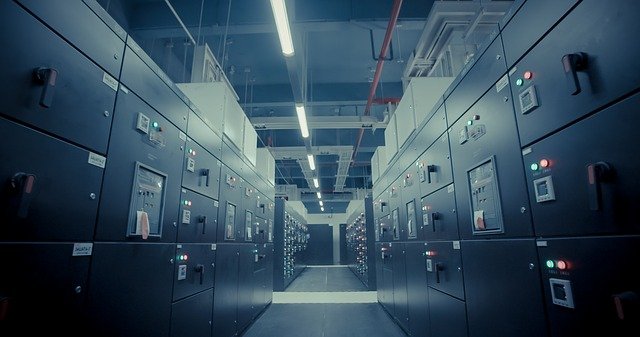
To avoid
problems with asset master data quality and to ensure integrity of crucial
business data, master data governance is necessary. In addition to methods for
producing and maintaining master data, quality and business rules, access permissions,
data distribution, security, and usage, governance provides a quality framework
for managing data elements and structure.
The maintenance superintendent is typically responsible for guiding policy, standards, and procedure to drive data quality and is typically held accountable for the overall maintenance of data quality and integrity. He or she also serves as the final arbiter when it comes to approving new policies, procedures, and standards. The superintendent will prioritise and approve master data initiatives for process improvements, data cleansing, rules, and standards while keeping budget and resource constraints in mind. The superintendent will also make business investment decisions to support master data governance and related activities.
The Maintenance Budgeting Process

The main maintenance budget goals are as follows:
1. Establish safe and controlled procedures for initiating, planning, scheduling and performing maintenance tasks as well as documenting maintenance history
2. Create a maintenance budgeting process based on specific work requirements.
3. Maintain work plan costs, project expenditures and meet cost performance goals.
Data Based Decisions & Related Spending

If you put the effort into your CMMS it will help you understand the existing and future value of your maintenance intensive assets, as well as their overall effectiveness, uncover latent potential and improve service levels and production department satisfaction.
In most cases, maintaining and repairing an asset over the whole of its planned lifecycle is more cost effective than replacing it at a percentage of its life but let the data tell you this. In addition, there may be health, safety, environmental and even community risks associated with certain assets failing, but this is why these decisions need to be risk based and supported by data.
Depending on the nature of the asset, it’s possible that the costs of mitigating the failure risk of a well-maintained asset are far easier to accept than the financial waste incurred when asset replacements are done routinely and sometimes far too frequently.
Failure to replace an asset with a ‘Like for Like’ asset if you choose to replace it rather than repair it could result in tax repercussions.
Maintenance repairs and operational expenditures which include like-for-like replacements (up to a specific value) are typically expensed without difficulty at tax time. Non-like-for-like replacements and alterations, on the other hand, are frequently required to be capitalised.
Eliminating defects, the process and the benefits
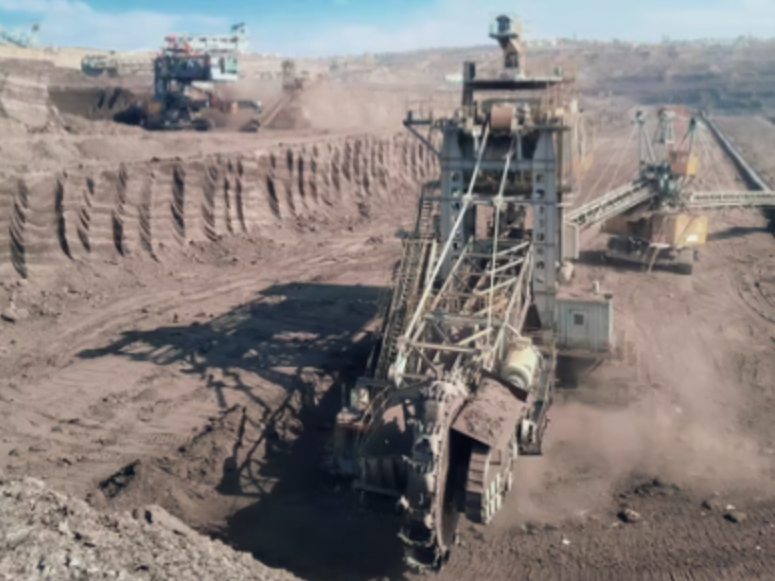
Using the right improvement measures, the defect elimination process aims to resolve business issues. It can be used to stop undesirable business impacts from happening repeatedly or to stop undesirable results from happening in the first place.
Defect elimination places a general emphasis on identifying cost-effective solutions, sharing learning across the business to prevent similar unplanned events, capturing undesirable outcomes in a timely manner, accurately and consistently defining problems as well as prioritising which problems to work on via a risk-based approach.
The Defect Elimination Process (DEM) begins with the identification of a “trigger,” which is an unwanted event or result that you want to prevent in the future. A negative result, a danger, or a business impact could be the trigger. Business impacts are things that have already happened, thus they are addressed only through the DEM process. On the other hand, threats and bad actors that have yet to occur should be handled through a Threat Management process.
It should be acknowledged that underlying risks can frequently be discovered for business implications throughout the DEM process, and these will serve as additional inputs to the Threat Management process. For instance, other installations may be put at risk if a bearing prematurely fails as a result of switching to a grease or oil with the wrong properties. The threat resulting from this one business impact would then spread to other areas of your company, which would need to be controlled independently in an effort to avoid failures similar to this one.
If your company is looking at putting a Defect Elimination Process in place, individuals will need to be trained in the following as a minimum:
1. Defect Elimination Fundamentals
2. How to identify problems
3. How to define a problem
4. How to measure problems
5. Root Cause Analysis
6. Process Improvement Implementation
7. How to ensure sustainable solutions
A Guide For Creating A Comprehensive Maintenance Manual.
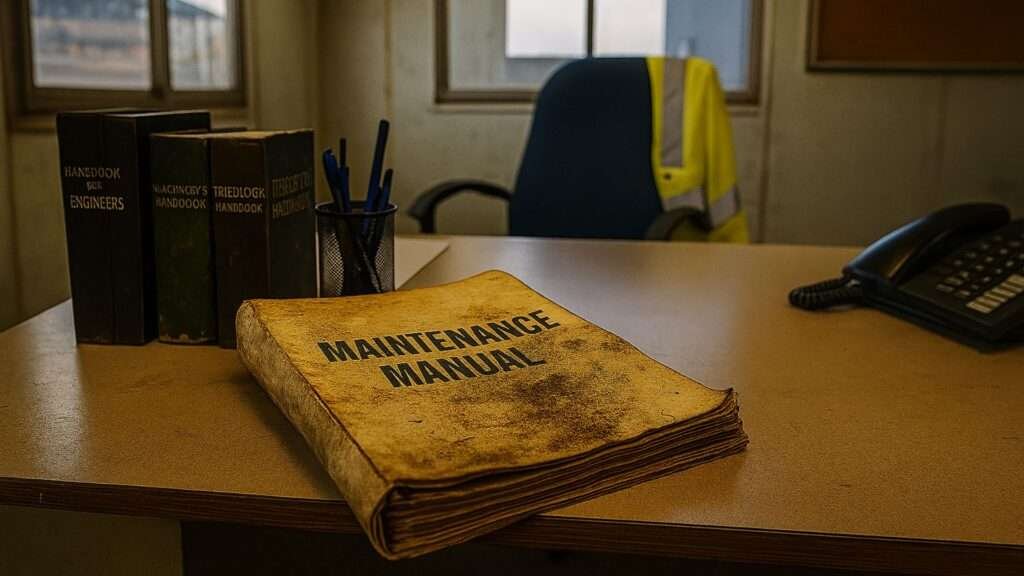
Back when I first started in the mining industry, the maintenance manual was the sacred text of industrial operations.
It lived in the supervisor’s office, dog‑eared and grease‑stained, containing every procedure, specification, and protocol needed to keep equipment running.
It was the blueprint for all work, the first port of call when something went wrong, and the training ground for every new technician.
Then came the digital wave. As organisations rushed to adopt CMMS platforms and other tools, the traditional manual fell out of favour.
Many must have assumed that dozens of smaller digital records would be enough, I’m not entirely sure.
The result? Fragmented knowledge, inconsistent practices, and a widening gap between what systems could track and what people actually needed to know.
A well‑designed maintenance manual, integrated with modern CMMS platforms, is the connective tissue that transforms scattered data into actionable intelligence.
It ensures consistency, compliance, and continuous improvement. Done right, it becomes the definitive reference point for your maintenance operation.
What Is a Maintenance Manual?
A maintenance manual is more than a collection of procedures. It’s a comprehensive framework that combines:
- Policy – your overarching philosophy, commitments, and governance.
- Procedures – standardised methods for routine tasks and workflows.
- Technical Reference – asset‑specific specs, troubleshooting guides, and OEM documentation.
Why Go Down This Path?
- Standardisation: Everyone follows the same playbook.
- Compliance: Safety and regulatory requirements are embedded in daily work.
- Training: New technicians learn faster with documented institutional knowledge.
- Knowledge retention: Practices survive staff turnover.
- CMMS integration: The manual closes the loop between planning, execution, and improvement.
Who Uses It? Basic List.
- Technicians: Step‑by‑step procedures with safety protocols.
- Supervisors/Planners: Work packages, resource estimation, scope management.
- Engineers: Modifications, RCA, and improvement initiatives.
- Contractors: Standards for seamless integration.
- Auditors/Compliance Officers: Verification of robust systems.
Core Components.
- Maintenance Policy – preventive vs predictive balance, safety commitments, accountability.
- Asset Register & Profiles – hierarchy, criticality, OEM references.
- SOPs – inspections, preventive tasks, condition‑based monitoring.
- Workflows & Work Orders – request → approval → execution → close‑out.
- Metrics & KPIs – MTBF, MTTR, backlog, schedule compliance.
- Safety & Risk Management – permits, lockout/tagout, hazard reporting.
- Materials & Spares – inventory control, critical spares, vendor management.
- Shutdowns & Turnarounds – planning, risk mitigation, post‑event review.
- Change Management – version control, feedback loops, continuous improvement.
Step‑by‑Step Guide.
- Define scope and objectives.
- Engage stakeholders across maintenance, safety, engineering, and finance.
- Gather existing documentation and identify gaps.
- Develop a clear structure and hierarchy.
- Write content in plain, practical language.
- Integrate with your CMMS for point‑of‑need access.
- Validate with SMEs and frontline staff.
- Pilot, refine, and scale.
- Train staff and embed into onboarding.
- Control versions and updates.
- Review annually and after major incidents.
- Audit compliance and effectiveness.
Modernising the Manual.
- Digital integration: Embed within CMMS and mobile apps.
- Interactive content: Diagrams, videos, QR codes.
- Searchability: Tagging, indexing, and quick lookup.
- Training integration: Tie to e‑learning and competency tracking.
- Future‑proofing: AI, AR, and predictive analytics.
Common Pitfalls.
- Over‑complication: Too much detail makes it unusable.
- Lack of ownership: No one accountable for updates.
- Ignoring frontline input: Misses practical realities.
- Treating it as a one‑off project: It must evolve.
- Weak business alignment: Disconnect from safety, compliance, and cost goals.
Note.
A well‑crafted maintenance manual is not a relic of the past, to me, it’s the foundation of modern reliability.
It doesn’t limit flexibility; it enables it.
By capturing institutional knowledge, embedding safety and compliance, and integrating with your CMMS, the manual becomes the living blueprint for operational excellence.
If you’re starting from scratch, begin with your most critical assets and processes. If you already have a manual, now is the time to review its relevance, integrate it with your digital systems, and commit to ongoing stewardship. To me, the payoff is clear: safer operations, more reliable assets, and a culture of continuous improvement.
Conclusion.

A quality maintenance manual is far more than a document, it is the anchor point of an entire asset management system.
From setting clear policies and metrics, to guiding shutdowns, budgeting, and defect elimination, the manual provides the structure that ensures every process is safe, compliant, and aligned with business goals. It captures institutional knowledge, embeds best practice, and connects the day‑to‑day work of technicians with the long‑term strategy of the organisation. In an era where digital systems and CMMS platforms dominate, the maintenance manual remains the living blueprint that unites people, processes, and technology. It transforms scattered data into actionable intelligence, ensures consistency across teams, and safeguards both assets and people.
Whether you are starting from scratch or modernising an existing framework, the message is clear: invest the time to build and maintain a comprehensive manual. Keep it practical, keep it current, and keep it integrated with your systems.
The payoff to me is lasting, safer operations, more reliable equipment, stronger compliance, and a culture of continuous improvement that protects your licence to operate and strengthens your business for the future.
Page Analysis.
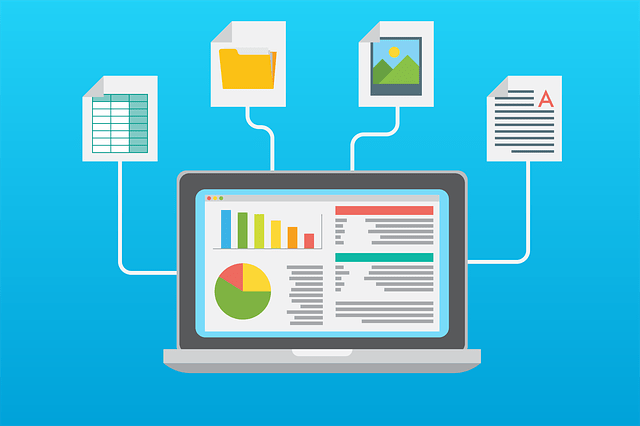
1. The intent of this page.
This page provides a practical, end-to-end framework for building a quality maintenance manual and policy, tying together asset management principles, effectiveness metrics, baselines, shutdown planning, P&IDs, materials management, master data governance, budgeting, defect elimination and a modern guide to authoring the manual itself.
Its goal is to help leaders and practitioners convert scattered knowledge and CMMS data into a single, living blueprint that standardises work, embeds safety and compliance, and enables disciplined, continuous improvement across teams.
2. Why this page matters.
Without a unified manual, organisations risk inconsistency, safety exposures, and weak performance feedback loops; by codifying policy, workflows, and metrics, teams can benchmark, improve, and sustain reliability at scale.
Integrating proven practices such as Lean Six Sigma and structured maintenance strategy methods (FMECA/RCM) strengthens data-driven decision-making, prevents reactive drift, and elevates quality, uptime, and cost control.
3. Bibliography (1) – Directly relating to this page.
These references align with the concepts and methods discussed here.
- Defining quality maintenance systems: CMMS Success
- Essential basics of equipment maintenance: CMMS Success
- Develop maintenance strategies (category hub): CMMS Success
- Maintenance excellence with Lean Six Sigma: CMMS Success
- Develop effective maintenance strategies to ensure success: CMMS Success
- Complete maintenance systems audit guide: CMMS Success
- 5 step maintenance systems auditing: CMMS Success
- Interface disparate systems data with a CMMS via AVEVA PI: CMMS Success
- What is a maintenance shutdown: CMMS Success
- Set up maintenance and operations systems: CMMS Success
- The six big losses – OEE – TPM – RCM: CMMS Success
4. Bibliography (2) – Conduct further research.
Use these sources to extend your understanding, validate approaches, and explore adjacent disciplines.
- How to produce effective operations and maintenance manuals (ASCE – front matter): ASCE Library
- How to produce effective operations and maintenance manuals (book overview): Google Books
- How to create an operations & maintenance manual (+template): Whatfix
- How to create an O&M manual (step by step): WorkTrek
- Effective maintenance manuals (overview): Number Analytics
- Engineering Maintenance Solutions – books for maintenance leaders: EMS
- Asset Management – An Anatomy (IAM): Institute of Asset Management
- SMRP body of knowledge: SMRP
- Maintenance and reliability best practices (Gulati): CRC Press
- Reliability-centered maintenance (Moubray): Industrial Press
- ISO 9001 – quality management systems: ISO
- Plant Engineering – CMMS and maintenance articles: Plant Engineering
Contact Us.

We're Ready, Let's Talk.
Contact Info
Address
PO Box 784, Muswellbrook, NSW, Australia
Email Us
admin@cmmssuccess.com
Call Us
0448 687 451


